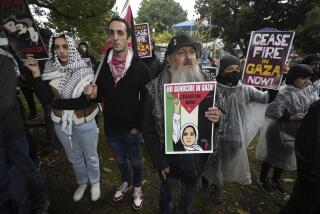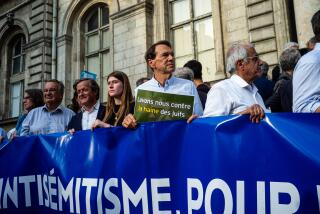A War Atrocity Not Forgotten
PARIS â Stephen Draisin, an American lawyer, was shocked last summer when he visited the old German Natzweiler-Struthof concentration camp near Strasbourg and found only a large wooden cross as a religious memorial.
True, most of the prisoners at the camp, a former ski resort in the Vosges mountains southwest of Strasbourg, were Christian French Resistance leaders, Russians and Romanians.
Macabre Experiment
But Draisin, 42, a real-estate specialist from Hoboken, N.J., knew from his research that at least 87 Jewish men and women had been gassed to death there as part of a macabre anatomical experiment by a German professor of medicine at nearby Strasbourg University. To his astonishment, he found nothing at the camp, restored by the French government in 1960, to memorialize the dead Jews.
âWhat I was upset about was an error of omission,â he said in a recent telephone interview. âI had no objection to the cross being there, but I knew that other people had been killed only because they were Jewish. By omitting them from the memorial, I felt, the French government was denying that this had taken place.â
With the help of the Simon Wiesenthal Center in Los Angeles, Draisin undertook an intense correspondence with the French government calling for a Star of David memorial to be placed alongside the cross at the camp.
Draisinâs letter campaign followed an effort of several years by French Nazi-hunter Serge Klarsfeld, president of the Sons and Daughters of Jews Deported From France, to have the Jewish deaths mentioned at the annual memorial ceremony at the camp.
As a result of these efforts, French officials finally agreed last month to honor the Jewish victims. Draisin, Klarsfeld and representatives of French Jewish organizations have been invited to the annual ceremony Saturday at Struthof.
A plaque bearing the Star of David and the following inscription is to be placed there: âIn the month of August, 1943, 87 Jews, including 30 women, deported from the camp at Auschwitz, were murdered in a Struthof gas chamber for the purpose of collecting skulls and skeletons for the Institute of Anatomy at the Nazi University. This plaque is placed here in memory of the millions of Jewish victims of genocide.â
Shimon Samuels, European director of the Wiesenthal Center, said, âThe hero of this story is an American lawyer who wanted to make sure these victims would not be forgotten.â
Draisinâs appeals first were rejected by French authorities, one of whom claimed that the cross was an âecumenicalâ memorial for victims of all religions.
âThere was a tendency on the part of French officials to present Struthof as âthe French campâ and memorial to the Resistance,â Samuels said, âbut there were also many Soviets, Romanians, Gypsies, Algerian Muslims, Freemasons and Communists in the camp.â
Four-Year Effort
Before Draisin began his campaign, French officials had resisted Klarsfeldâs four-year effort to take part, on behalf of Jewish victims, in the annual memorial ceremony conducted by the French ministry in charge of veterans and war victims. Klarsfeld edited a 1985 book, âThe Struthof Album,â that details the efforts by Strasbourg University professor August Hirt to collect Jewish skulls and skeletons for his research.
âBy procuring the skulls, which represent a repulsive yet characteristic subhumanity, we have the opportunity of obtaining tangible scientific evidence,â Hirt wrote in a 1942 letter to Berlin.
In an age of horrors, the Struthof killings were among the most horrible that took place on French soil in World War II. An estimated 115 Jews were selected at the German death camp at Auschwitz and transported to the camp in the French mountains. Only 87 of them, 30 women and 57 men, actually made it to the camp for âtreatment.â
All were gassed in a converted cold-storage locker and their remains were placed in alcohol for study. Most were destroyed when the German forces retreated, but 16 bodies were found in the cellers of Strasbourg University, some still bearing their Auschwitz identification tattoos, when Allied armies arrived in 1944.
Museum and Graveyard
Besides the restored buildings and museum, the camp is also a graveyard for 1,120 French victims who died in other concentration camps in Germany.
The camp is in an area of strong anti-Communist sentiment, and some have suggested that this explains the reluctance to portray the camp as something more than a memorial to the French Resistance. In this view, honoring Jewish victims at the camp would open the door to honoring Communists who were killed or imprisoned there.
Despite repeated efforts, Serge Barcellini, the veterans ministry official in charge of commemorations, could not be reached for comment. Barcellini is the man who informed Draisin on Oct. 25 that âit is not possible to grant your request and I express my regrets.â
A key factor in the change of heart by French officials may have been the intervention of Marie-Madeleine Fourcade, a heroine of the French Resistance. Contacted by the Wiesenthal Center, Fourcade wrote a message of support for a Jewish monument.
A Jewish Hero
âOne of the heroes of my Resistance network,â she said, was a French Jew named Philippe Koenigswerther.
Koenigswerther, a member of a prominent family, had the chance to flee France to safety in the West. Instead, Fourcade said, he stayed to fight with the Resistance and was arrested and killed at Struthof.
âI hope this monument will be placed there to commemorate his immense virtues,â she said.
Draisin said: âI donât care who gets the credit. This plaque will be there long after we are all gone.â
More to Read
Sign up for Essential California
The most important California stories and recommendations in your inbox every morning.
You may occasionally receive promotional content from the Los Angeles Times.










